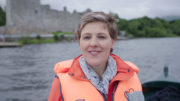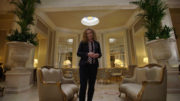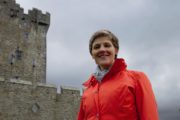Episode 4
Our fourth episode centres around the world-famous tourist town of Killarney, which attracts hundreds of thousands of visitors each year, from all around the globe. Geographer Susan Hegarty investigates what made this area such a prime target for the burgeoning tourism industry in the 18th century.
“The beauty is natural but its status as a haven for tourists is entirely manmade. Killarney is often cited as the birthplace of Irish tourism – an industry which has served as a cornerstone of Building Ireland.” Susan Hegarty.
The history of modern Killarney begins as a tale of two families – the Herberts and the Brownes.
“Thomas Browne, the fourth Viscount of Kenmare, had an idea. He realised that the wealth of Killarney wasn’t buried beneath the landscape – it was the landscape. And with that brainwave, the Irish tourism industry was born.” Susan Hegarty.
Susan meets with local tourism expert Conor Doolan at the newly restored Killarney house, to discuss the relationship between the Browne family and the development of tourism in Killarney.
“It was in their own self-interest to develop not only industries like milling and mining and the linen industry, but he also had to develop the tourist industry to run such a vast estate… The estate itself is about 6 times the size of the present-day Killarney National Park.” Conor Doolan
“There would have been an entrance fee into the estate. They would have kept coaches here in the stables where we’re standing today. Lord Kenmare also controlled the boats on the lakes in the area so if you wanted to take the boats you were essentially paying Lord Kenmare for a boat journey around Killarney lakes.” Conor Doolan
With the birth of the Romantic Movement, tourism became less about gallivanting through the great cities of Europe, and more about seeking solitude of nature – with a degree of comfort, of course. Kerry had the scenery but was almost completely inaccessible. A technological revolution was about to change all that.
“From the 1830’s, the railways started to spread across Ireland like an iron rash. In 1853, Lord Kenmare persuaded the Great Southern and Western Railway to extend their line down to here. And Killarney has never been the same.” Susan Hegarty.
Architect Orla Murphy investigates how the Railway hotel, possibly the first hotel built by a railway company in Europe, established a model of comfort and convenience that would be copied the world over.
“Architect Frederick Darley designed the hotel in the style of a great country house; but this wasn’t just a bed for the night – it was itself part of the once great spectacle of Killarney – designed, inside and out, to take the visitors’ breath away.” Orla Murphy.
Orla meets with Frank Corr, who has written a history of the Great Southern Hotel, and who describes why the hotel was designed and run in such a grand fashion.
“If you were building a hotel aiming at that particular market, you had to exceed their expectations. You had to have it even more grand if you could than their homes – so a dining room like this with its beautiful bordered ceiling, its elaborate plasterwork; they would admire the marble pillars. They would admire the gold leaf that was everywhere.” Frank Corr
“They wanted the hotel to look a bit like the grand houses they would be used to in England. They wanted comfortable beds and they particularly wanted servers. They wanted staff to be at their beck and call.” Frank Corr
The Great Southern Hotel was home to luxury and indulgence, an entirely new concept in personal leisure. But the hotel business was just one of the industries that sprang up in Killarney as visitors flocked here in the 19th century. At a time of poverty and suffering throughout Ireland, tourism kept Killarney afloat. Susan meets with Mike O’Connor to discuss what life was like in the town, with the industries being so seasonal.
“People lived in real poverty and in I suppose maybe, some might even say squalor. There was no indoor plumbing as we would say now, and they would have reared pigs in the back yard. You can imagine the stench and all that good stuff. They would have collected the slops from the hotels to feed the pigs.” Mike O’Connor
“They would be employed during the summer because, as you know, the hotels in the Victorian times put together the package for the visitors. So you had boatmen, you had hotel porters, you had guides – all had to live and survive during the winter. And they would have lived down these lanes here in Killarney where we walk now.”
Mike O’Connor
Killarney was closer and cheaper than the continental spa towns, and it gained a reputation for cleansing body and mind. And with the coming of the railways, this remote corner of Ireland suddenly became accessible and desirable. All of Kerry knew that the railway was the path to the future, and engineer Tim Joyce is discovering that meant laying down tracks in some of the most inhospitable terrain in Ireland.
“The mountains in this part of Kerry presented a serious engineering challenge. Shale rock and solid limestone were the physical challenges and the sheer inaccessibility of this remote peninsula meant heavy and cumbersome steam machinery couldn’t be used to excavate, drill, or bore. There was only one option – the line would have to hug the coast. It took three years and almost a quarter of a million pounds before the job was done. By the end, what they’d created wasn’t just a practical coastal railway – it was one of the most scenic journeys in Europe.” Tim Joyce
Tim meets with local railway enthusiast Pat Kavanagh, to discuss the impressively curved Gleesk Viaduct.
“There’s no straight line in this railway line from Farranfore to Valentia. There were 1,200 men, of which 272 were skilled labourers and the skilled labour was men working with stonework. The feats of engineering in the work of stone was second to none, the stream, the culverts that were put in, the bridges that were build, the stone piers that were put in right through the area were huge, and without any machinery whatsoever. 100% manual labour throughout the project.” Pat Kavanagh
“The line is long gone, but its legacy lives on in tourist trails like the Ring of Kerry and Wild Atlantic Way. Not bad, for a little narrow gauge railway.” Tim Joyce.
On the 26th of August 1861, the train from Dublin delivered a very distinguished guest to Killarney – Queen Victoria herself, accompanied by Prince Albert and other members of the Royal Family.
“The tourist experience hasn’t changed much since Victoria’s time. This isn’t the old story of tourism selling local traditions – in Killarney, tourism is the local tradition.” Susan Hegarty
“Being driven around these wild surroundings, it’s easy to imagine yourself as the lord or lady of the manor – as long as you ignored a couple of others that were thinking the same thing!” Susan Hegarty
Susan talks to Jerry O’Grady, to discuss the impact Queen Victoria’s visit had on the area.
“Her visit gave us the platform to expose internationally what we had to offer. And now we had access through the railway, which was critical as well. We now had a vehicle… I’d be wary of calling Queen Victoria a ‘vehicle’ but that’s essentially what she was for our industry. And it enabled us to put abroad every one of the features that she visited – every step she made, every conversation literally that she had, everybody she met. They were all covered in great detail in media like the London Illustrated Times. And it became the routine itinerary for groups and for individuals after that.” Jerry O’Grady
Susan concludes the episode by summing up Killarney as a location, past and present.
“For the Victorians, Killarney meant refuge, peace, sanctuary. For modern visitors, it’s everything from a health retreat to a social experience. Killarney is as much a concept as a physical place – and for that, we can thank some very modern thinking over 200 years ago.” Susan Hegarty





